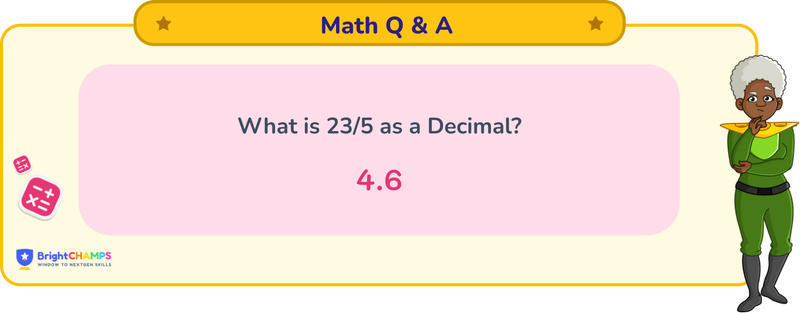Summarize this article:
 220 Learners
220 LearnersLast updated on August 5, 2025
23/5 as a Decimal

It is a simple question on decimal conversion. Firstly, we have to learn fractions and decimals. A fraction represents a part of the whole. It has two parts, the numerator (number on the top) here, 23 represents how many parts out of the whole. The denominator (number below) shows how many parts make the whole, here it is 5. A decimal is a way to represent the number that is not whole, using a (.) or a decimal to separate the whole part from the fraction part. The numbers to the left of the decimal point represent the whole, and those to the right represent the fractional part.

What is 23/5 as a decimal?
 Answer
Answer
23/5 in decimals can be written as 4.6. It is a terminating decimal, showing it does not repeat infinitely.
Explanation
To get 23/5 in decimal, we will use the division method. Let's see the step-by-step breakdown of the process:
Step 1: Identify the numerator and denominator because the numerator (23) will be taken as the dividend and the denominator (5) will be taken as the divisor.
Step 2: As 23 is greater than 5, we can directly divide it.
Step 3: Divide 23 by 5, which gives 4 as the quotient because 5 × 4 = 20.
Step 4: Subtract 20 from 23 to get a remainder of 3.
Step 5: Bring down a 0 to the remainder, making it 30, and continue the division process.
Step 6: Divide 30 by 5, which gives 6 as the quotient, because 5 × 6 = 30. Since there is no remainder, the division process ends, resulting in a terminating decimal.
The answer for 23/5 as a decimal will be 4.6.

Important Glossaries for 23/5 as a decimal
- Fraction: A numerical quantity that is not a whole number, representing a part of a whole.
- Decimal: A number that uses the base ten and includes a decimal point to separate the whole part from the fractional part.
- Numerator: The top part of a fraction, indicating how many parts of the whole are being considered.
- Denominator: The bottom part of a fraction, showing how many parts make up a whole.
- Terminating Decimal: A decimal that ends and does not repeat infinitely.





